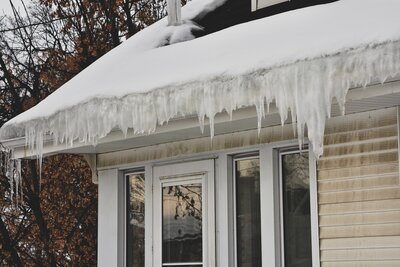Table of Contents
- Do Icicles Mean I Have Poor Insulation?
- Do icicles Always Mean I Have an Ice Dam?
- What To Do About Icicles On Roof?
- Why Should You Keep Your Home Insulated?
- Book Your Free Estimate
Understanding the Connection Between Icicles and Poor Insulation: Causes, Risks, and Solutions
During cold winter months, the sight of icicles on the roof doesn’t come as a surprise. In fact, many people will completely disregard this issue, blaming it solely on low temperatures.
However, if you’re a homeowner, you may have heard of the connection between roof icicles and bad attic insulation. What do icicles on your house mean, and when do roof icicles indicate poor insulation? Read on to learn more.
Do Icicles Mean I Have Poor Insulation?
While a few icicles are usually harmless, their presence doesn't always indicate poor insulation.
However, if icicles are accompanied by an ice dam—a thick ridge of ice at the roof edge—you might have poor insulation or attic ventilation.
Icicles form when water dripping from the roof's edge freezes as temperatures drop below freezing. Ice dams form when heat escapes through the roof, melting snow that refreezes at the edges. Ice dams can block water flow and damage your roof.
Here is a picture of icicles and an ice dam:

Proper eavestroughs, clean gutters, and a well-insulated attic can minimize icicle formation and prevent ice dams.
Do Icicles Always Mean I Have an Ice Dam?
No, icicles don't always mean ice dams are on your roof.
However, to determine whether ice poses a threat to your house, it is important to understand the difference between an icicle and an ice dam.
Icicles Vs. Ice Dams
Icicles
Icicles can form without ice dams. This happens when snow melts on your roof, and the water refreezes as it drips off the edge. As we’ve mentioned, an icicle is a cone-shaped ice formation hanging off the edge of your roof, and it is not necessarily indicative of improper insulation.
Generally, an ice dam may not be present if the icicles are only on your gutter. While some icicles on the roof are usually not considered harmful to your home, the same can’t be said for ice dams.
Ice Dams
An ice dam a buildup of ice on your roof (usually in the gutter) that forms during heavy snowfall in extremely low temperatures. Ice damming on your roof can be a symptom of poor attic insulation, and it can even lead to further damage, such as water leaks.
What are the signs of an ice dam? Here are a few:
- Ice Buildup Along the Eaves. You probably have an ice dam if you see a thick ridge of ice at the edge of your roof.
- Thick Icicles On the Eaves and Soffit. Another sign of an ice dam is a large cluster of thick icicles on the eaves or soffit.
- Water Stains. Finally, take a quick peek in your attic and look for water stains on the ceiling or walls. If you see water stains, ice dams are probably an issue.
If you think you have an ice dam, don't panic! As with all home issues, it can't be fixed. Contact your local iFOAM to book your free attic insulation consultation.
What To Do About Icicles On Roof?
A couple of icicles forming under the eaves shouldn’t be too much of a problem. That being said, a greater accumulation of icicles around the roof imposes a threat to your safety, and it could also lead to ice damming, which is a serious issue.
Install Troughs and Heating Cables
If icicles tend to form on your roof, one of the solutions could be to install proper troughs and ensure that they’re clog-free. Adding a heating cable inside these troughs could also prevent freezing in winter months.
Keep in mind that preventing icicles from forming on the roof if you don’t have troughs or gutters is quite challenging, as having a functioning drainage system is extremely important.
Improve your Attic Insulation
Persistent and substantial icicle forming and ice damming could be a warning that your attic requires additional insulation. In this case, you may want to reach out to an experienced insulating contractor and schedule a consultation to find the best insulation solution and avoid potential water damage, as well as increased energy costs.
Why Should You Keep Your Home Insulated?
When snow accumulates on your roof, if your attic is not properly insulated, the striking temperature difference could lead to ice damming. As the heat inside your poorly insulated attic will melt the snow, the melted water will end up in the gutter where the refreezing will occur due to a contrast in temperatures.
This is exactly how ice dams are formed inside the gutter, jeopardizing the draining process and potentially leading to mold, as well as structural damage to your roof.
Quality air sealing should keep your attic cool enough to prevent the snow blocks from melting and overwhelming the gutters.
Dealing with Ice Dams? Book Your Free Estimate!
Accumulation of ice on your roof, whether it be icicles or ice dams, could be a warning that your attic is not properly insulated. Do you need your attic insulation improved? We can help. Schedule a free consultation with an iFOAM insulation specialist at (855) 935-4723 today to learn how you can protect your home from ice damming, water leaks, and structural damage.

